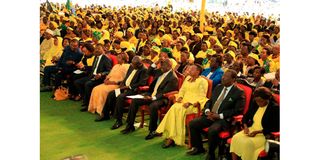Why Kenya Kwanza's all-women media crew invite was a miss

Deputy President Dr William Ruto with other Kenya Kwanza leaders during Kenya Kwanza women charter conference at Nyayo National Stadium on June 10, 2022. The event organisers had asked for an all-female media crew.
What you need to know:
- Kenya Kwanza's media invite requesting coverage of a women-related event was historic in the Kenyan media industry.
- UDA communication director says "Women issues are best communicated by women themselves. Men issues are best communicated by men."
On June 9, Wanjohi Githae, the United Democratic Alliance (UDA) communication director sent out a media invite requesting coverage of a women-related event.
UDA party leader and Kenya Kwanza Presidential candidate Dr William Ruto was to sign a Kenya Kwanza Women Charter at Nyayo Stadium the following day.
Their invite was, however, historic in the Kenyan media industry.
“We encourage your media house or online news blog to deploy an all-women crew as we seek to celebrate and highlight the important role played by women in all sectors,” read a note to the editors.
What informed this kind of invite?
I pose this question to Mr Githae and his response is: “Women issues are best communicated by women themselves. Men issues are best communicated by men. Police issues are best communicated by police. Ad Infinitum.”
He adds: “It was not mandatory, it was a mere suggestion to ensure that our message was well articulated. We are happy that our message was well communicated.”
Gender-balanced content
Well, in the spectrum of four frameworks that guide production of gender-balanced content, UDA made some big misses. But it shook the web of Kenya’s media industry.
A gender-balanced content takes into account the prominence of women as news sources and equality of the women’s voices and opinions, including having equal number of women reporters on a beat.
A story that portrays men and women without bias and packages the content for the interest of consumption of both gender, is gender-balanced.
By suggesting coverage by an all-women crew, UDA was inadvertently promoting prominence of women in political news and inclusion of women in political reporting.
As at 2020, according to Global Media Monitoring Project report by World Association for Christian Communication, only 20 per cent of newspaper articles on politics were by women reporters against 28 per cent by men reporters.
Furthermore, a 2015 Media Council of Kenya analysis of gender equality in the Kenyan media, found that men reported 72 per cent of print stories and 46 per cent of the radio and television
Male legislators
This shows a huge gender disparity in news gathering.
The invite, however, failed in portrayal aspect. It reinforced a stereotype that only women can cover women events, an attitude that resulted in a four-time failure in passage of the two-thirds gender bill. The male legislators and the public viewed it a “women’s bill” that would only benefit the women, yet it was about equality in representation of men and women in Parliament.
Only 29 per cent of newspaper, television, and radio reporters in Kenya are women, far below South Sudan’s 37 per cent and Tanzania’s 35 per cent, provides GMMP 2015 data.
In the past two decades, however, there has been steady progress globally in men reporters including women as news sources in their stories, an outcome of consistent trainings by media and women rights organisations.
In 2020, 24 per cent of people covered by men reporters were women, a rise from 18 per cent in 2000.
Ms Judy Kaberia, Executive Director of Association of Media Women in Kenya, one of the organisations that trains journalists on gender-sensitive reporting holds that: “The coverage of women is not about women covering women, but journalists covering both genders equally.”





